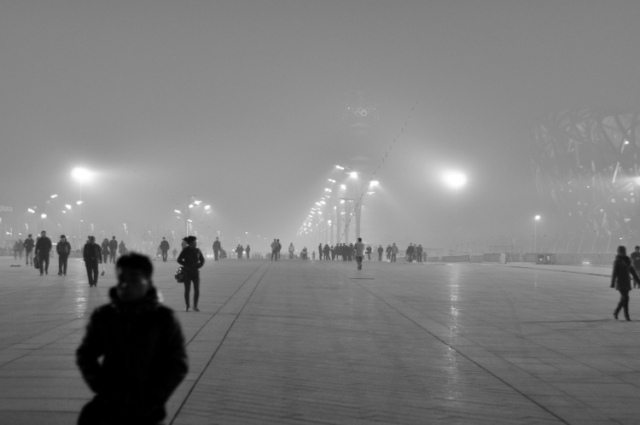By Jessica Rowe
When Obama arrived in Beijing on Monday, he arrived to a pretty spectacular greeting—but perhaps even more impressive, but less-talked about, was the fact that the sky was blue.
That may not seem like anything noteworthy. It’s a fact of life—the grass is green, the sky is blue. Right?
But in Beijing, that’s far from the case. China’s burgeoning economy and the rise of their middle class has led to a massive environmental crisis: higher consumer demand means more cars on the road, more coal being burned for energy and economic growth. As far back as 2000, China was producing over five times the amount of carbon per dollar spent on the economy than its leading “competitor” the United States.
The result is that China’s air quality, particularly in the large cities, is at best a moderate health hazard—at worst, it’s deadly. And it doesn’t just stop at air pollution. Rapid deforestation has been a problem, as well as the dust storms caused by the pollutant-fueled expansion of the Gobi desert.
I remember the first time I encountered pollution on such a scale. It’s incredibly strange to be able to feel the heaviness of the air as it hangs in your throat, sinks into your lungs. Even after I left, I sneezed black gunk for weeks.
For the citizens of China, however, that’s everyday life. In 2012, nearly 670,000 people died from smog-related pollution. There are multiple apps that monitor China’s air quality index, alerting citizens when it is and isn’t safe to go outside, or when harmful pollutants like PM2.5 are concentrated in the air.
Experts have even claimed that China’s pollution is so bad that it now compares to a nuclear winter.
So how exactly did a rare blue sky happen to present itself?
President Obama’s theatrical greeting wasn’t the only production orchestrated for his arrival: the Chinese government has enacted several strict mandates that regulate life in and around Beijing in order to present a “cleaner” capital for the Asia-Pacific Economic Conference, which runs from the 5th to the 11th of November.
In the weeks leading up to the conference, the government closed thousands of factories, while the rest were forced to reduce emissions by up to 30 percent. They declared the past six days a national holiday, “APEC Golden Week,” in attempt to lure Beijing citizens away from the city during the conference.
There are restrictions on traditional ceremonies, construction, driving, and even health care—all to bring about a clear “APEC blue.”
It’s a stop-gap attempt to improve pollution before a gathering of the leaders of major economic powers. In the long term, however, life as the Chinese know it is forever changed. Efforts have been made to stem the tide of pollution, but is it enough?
China’s problem is the world’s problem. Pollutants from China are carried throughout the region in “Asian Dust” on natural prevailing wind patterns. Recently it was found that over 29% of San Francisco’s pollution comes from China.
But do we really have to wait until the danger reaches our own shores before we take action? The APEC blue might have looked nice, but in reality it was no more than a smokescreen for those gathered at the conference, one which they hopefully can see straight through.
About the author:
Jessica Rowe is a multigenre writer based in Los Angeles. In 2010, she graduated university with degrees in creative writing and Asian studies. In 2014, she directs creative projects at a marketing firm by day, and writes, travels, studies, and writes some more by night (and weekend). Find more of her work at her new blog willwriteforchai.com.
Photo by Kenneth | Flickr



